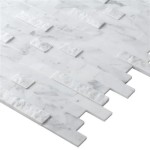Non-Slip Kitchen Floor Tiles: A Comprehensive Guide
The kitchen, often considered the heart of the home, is a high-traffic area prone to spills, moisture, and potential slip hazards. Choosing the right flooring is crucial for safety, durability, and aesthetics. Non-slip kitchen floor tiles offer a practical solution, minimizing the risk of accidents while providing a visually appealing surface. This article explores the various aspects of non-slip kitchen floor tiles, including types, textures, testing methods, installation considerations, and maintenance tips.
Selecting the appropriate flooring for a kitchen environment requires careful evaluation of several factors. Beyond aesthetics, safety is paramount. Slippery floors can lead to serious injuries, especially in households with children, elderly individuals, or those with mobility challenges. Furthermore, kitchen floors are subject to frequent cleaning and exposure to liquids, greases, and food particles. Therefore, the chosen flooring must be durable, water-resistant, and easy to clean. Non-slip tiles address these concerns by providing a textured surface that enhances traction, even when wet.
Understanding Slip Resistance Ratings
Slip resistance is scientifically measured and categorized using various rating systems. These ratings help consumers understand the level of traction a particular tile provides. Two commonly used standards are the Ramp Test (DIN 51130) and the Pendulum Test (EN 1339). The Ramp Test involves walking on a tile surface at increasing angles until slipping occurs. The angle at which the slip occurs determines the R-value, with higher R-values indicating greater slip resistance. The Pendulum Test measures the slip resistance of a surface using a pendulum device that simulates the heel strike of a pedestrian. The result is expressed as a Pendulum Test Value (PTV), with higher PTV values indicating better slip resistance.
The DIN 51130 standard classifies slip resistance into five categories: R9, R10, R11, R12, and R13. R9 offers minimal slip resistance and is generally suitable for dry areas with low pedestrian traffic. R10 is commonly used in bathrooms and kitchens, providing moderate slip resistance. R11 is recommended for areas with frequent water exposure, such as commercial kitchens and showers. R12 and R13 offer the highest levels of slip resistance and are typically used in industrial settings with oily or greasy environments.
The EN 1339 standard, using the Pendulum Test, categorizes slip resistance based on PTV values. Generally, a PTV of 36 or higher is considered low slip potential. Values between 24 and 35 indicate a moderate slip potential, while values below 24 indicate a high slip potential. When selecting non-slip kitchen floor tiles, it is crucial to consider the specific needs of the environment and to choose tiles with an appropriate slip resistance rating based on these standardized tests. Consulting with a flooring professional can provide valuable guidance in interpreting these ratings and selecting the most suitable option.
Types of Non-Slip Kitchen Floor Tiles
Various materials and textures contribute to the slip-resistant properties of kitchen floor tiles. Some of the most common types include:
*Textured Ceramic Tiles:
Ceramic tiles are a popular choice for kitchens due to their durability, water resistance, and ease of maintenance. Textured ceramic tiles feature a surface with raised patterns, grooves, or ridges that enhance traction. These textures disrupt the water film that can form on smooth surfaces, providing a more secure footing. *Porcelain Tiles:
Porcelain tiles are denser and less porous than ceramic tiles, making them even more resistant to water and stains. Textured porcelain tiles offer excellent slip resistance and are suitable for high-traffic kitchens. They are available in a wide range of styles and finishes, allowing for aesthetic versatility. *Natural Stone Tiles:
Natural stone tiles, such as slate, travertine, and sandstone, often have a naturally textured surface that provides inherent slip resistance. However, some polished natural stone tiles can be slippery when wet. It is important to choose natural stone tiles with a honed or textured finish for optimal slip resistance in the kitchen. Sealing natural stone tiles is also advisable to protect them from stains and water damage. *Quarry Tiles:
Quarry tiles are made from natural clay and are fired at high temperatures, resulting in a dense and durable tile with excellent slip resistance. Their typically unglazed surface provides a natural texture that enhances traction. Quarry tiles are often used in commercial kitchens and food processing facilities due to their durability and slip-resistant properties. *Vinyl Tiles (Specifically Textured LVT/LVP):
Luxury Vinyl Tile (LVT) and Luxury Vinyl Plank (LVP) options often come with embossed textures that mimic the look and feel of natural materials like wood and stone. These textured surfaces enhance slip resistance and provide a comfortable and forgiving surface underfoot. LVT and LVP are also water-resistant and easy to clean, making them a practical choice for kitchens.The selection of the tile material should be based on a combination of factors, including slip resistance ratings, aesthetic preferences, budget considerations, and the specific requirements of the kitchen environment. Consulting with a flooring expert can help navigate the diverse options available and ensure that the chosen tiles meet the necessary safety and performance standards.
Installation and Maintenance Considerations
Proper installation is crucial for ensuring the long-term performance and safety of non-slip kitchen floor tiles. A level and stable subfloor is essential for preventing cracks and ensuring that the tiles remain securely in place. It is important to use a high-quality adhesive that is compatible with the tile material and the subfloor. The grout lines between the tiles also play a role in slip resistance. Wider grout lines can provide additional texture and improve traction. Epoxy grout is a durable and water-resistant option that is easy to clean and maintain.
Routine maintenance is essential for preserving the slip-resistant properties of kitchen floor tiles. Regular sweeping or vacuuming removes dirt and debris that can reduce traction. Spills should be cleaned up promptly to prevent staining and reduce the risk of slips. Using a pH-neutral cleaner is recommended to avoid damaging the tile surface or grout. Harsh chemicals or abrasive cleaners can degrade the texture of the tile and reduce its slip resistance.
Periodically, it may be necessary to deep clean the grout lines to remove embedded dirt and grime. A grout brush and a specialized grout cleaner can effectively remove stains and restore the grout to its original color. Sealing the grout lines can also help prevent staining and make cleaning easier. For natural stone tiles, periodic sealing is necessary to protect the stone from water damage and staining. Following the manufacturer's recommendations for cleaning and maintenance will help prolong the life of the tiles and maintain their slip-resistant properties.
Furthermore, strategically placing non-slip mats or rugs in high-risk areas, such as near the sink or stove, can provide an additional layer of safety. These mats should be securely anchored to the floor to prevent them from slipping or sliding. Regularly inspecting the floor for cracks, loose tiles, or damaged grout is also important. Addressing these issues promptly can prevent further damage and maintain the safety of the kitchen floor.
In conclusion, selecting and maintaining non-slip kitchen floor tiles is an investment in the safety and functionality of the home. By understanding the different types of tiles, slip resistance ratings, and installation and maintenance considerations, homeowners can make informed decisions that create a safe and aesthetically pleasing kitchen environment.

Gastronomy Kitchen Anti Slip Flooring With Swissgrip

Kitchen Tiles Anti Slip Subsequent Renovation

Altro Non Slip Safety Floor Heavy Duty Vinyl Commercial Kitchen Flooring R10 Ebay

Rimini Grey Stone Effect Anti Slip Porcelain Floor Tile

Gastronomy Kitchen Anti Slip Flooring With Swissgrip

60x60 80x80 Grey Glazed Matte Non Slip Floor Tile Porcelain Ceramic Tiles For Kitchen Made In Com

Anti Skid Tiles For Bathroom Kitchen Slip Floor Orientbell

Quarry Tile Applications Commercial Kitchen

Non Slip Kitchen Mats Anti Fatigue Mat Comfort Standing Waterproof And Oilproofkitchen Floor Rubber Backed Rugs Carpet For In
10 Pieces Bathroom Anti Slip Floor Tiles Waterproof Background Decoration Wall Stickers Kitchen Wallpaper Self Adhesive








